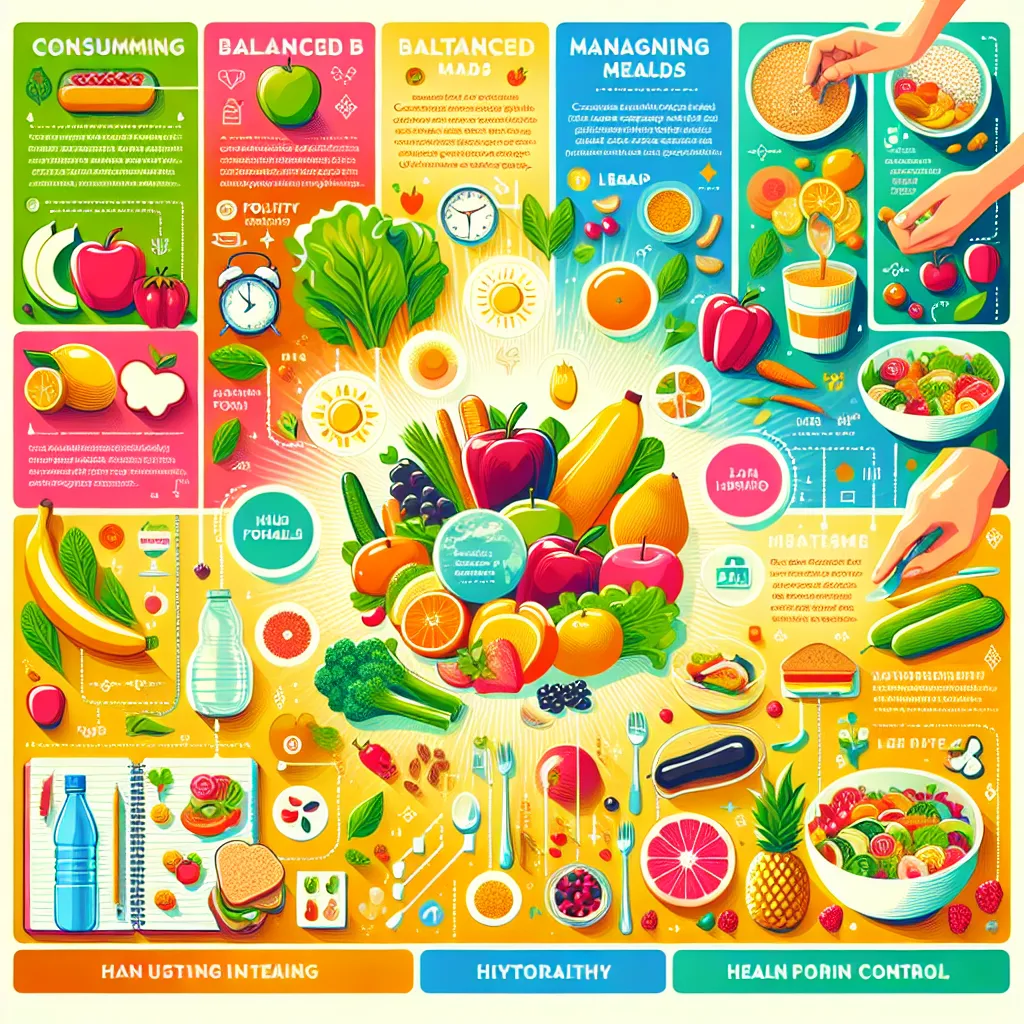The IELTS Reading section is a crucial component of the test, requiring candidates to demonstrate their ability to comprehend complex texts and answer various question types. Today, we’ll focus on a topic that frequently appears in IELTS exams: healthy eating. Based on historical data and current trends, it’s highly likely that you’ll encounter passages related to nutrition and dietary habits in your upcoming IELTS test.
Table Of Contents
Let’s dive into a practice exercise that mimics the format and difficulty level of an actual IELTS Reading passage. This will help you familiarize yourself with the exam structure and improve your skills in tackling health-related texts.
 Healthy Eating Tips Infographic
Healthy Eating Tips Infographic
Practice Reading Passage: The Science of Healthy Eating
Text
Healthy eating is not just about following the latest diet trends or cutting out entire food groups. It’s about understanding the science behind nutrition and making informed choices that benefit your overall health and well-being. In recent years, nutritional research has made significant strides in uncovering the complex relationships between diet, lifestyle, and health outcomes.
One of the most important principles of healthy eating is balance. A balanced diet includes a variety of foods from all major food groups: fruits, vegetables, whole grains, lean proteins, and healthy fats. Each of these groups provides essential nutrients that our bodies need to function optimally. For example, fruits and vegetables are rich in vitamins, minerals, and antioxidants that support immune function and help prevent chronic diseases. Whole grains provide fiber and complex carbohydrates for sustained energy, while lean proteins are crucial for muscle growth and repair.
Portion control is another key aspect of healthy eating. In many Western countries, portion sizes have increased dramatically over the past few decades, contributing to rising obesity rates. Learning to recognize appropriate portion sizes can help prevent overeating and maintain a healthy weight. A useful rule of thumb is to fill half your plate with vegetables, a quarter with lean protein, and a quarter with whole grains.
Hydration plays a vital role in healthy eating as well. Water is essential for numerous bodily functions, including digestion, nutrient absorption, and temperature regulation. While individual needs vary, a general guideline is to drink at least 8 glasses of water per day. It’s also important to limit sugary drinks, which can contribute to weight gain and increase the risk of type 2 diabetes.
Understanding food labels is crucial for making informed dietary choices. Nutritional information on packaging can help you compare products and choose options that align with your health goals. Pay attention to serving sizes, calorie content, and the amounts of key nutrients like sodium, added sugars, and saturated fats.
Mindful eating is an approach that encourages paying full attention to the eating experience, including the tastes, textures, and sensations of food. This practice can help improve digestion, reduce overeating, and increase overall satisfaction with meals. It involves eating slowly, savoring each bite, and listening to your body’s hunger and fullness cues.
Lastly, it’s important to recognize that healthy eating is not about perfection. Occasional indulgences are part of a balanced lifestyle. The key is to make nutritious choices most of the time while allowing for flexibility. This approach is more sustainable in the long term and can help foster a positive relationship with food.
By incorporating these principles into your daily life, you can develop eating habits that nourish your body, support your health, and contribute to overall well-being. Remember, small changes can lead to significant improvements in your diet and health over time.
Questions
1-5. Choose the correct letter, A, B, C, or D.
-
According to the passage, a balanced diet should include:
A) Only fruits and vegetables
B) A variety of foods from all major food groups
C) Exclusively whole grains and lean proteins
D) Primarily healthy fats -
The text suggests that portion sizes in Western countries have:
A) Decreased over time
B) Remained constant
C) Increased dramatically
D) Been regulated by the government -
What is the recommended guideline for daily water intake?
A) 4 glasses
B) 6 glasses
C) 8 glasses
D) 10 glasses -
The practice of mindful eating involves:
A) Eating as quickly as possible
B) Ignoring hunger cues
C) Paying full attention to the eating experience
D) Avoiding all indulgences -
According to the passage, which of the following is true about healthy eating?
A) It requires following the latest diet trends
B) It involves cutting out entire food groups
C) It allows for occasional indulgences
D) It focuses solely on calorie counting
6-10. Complete the sentences below.
Choose NO MORE THAN THREE WORDS from the passage for each answer.
-
Fruits and vegetables are rich in vitamins, minerals, and ___ that support immune function.
-
A useful rule of thumb for portion control is to fill ___ of your plate with vegetables.
-
Water is essential for numerous bodily functions, including digestion, nutrient absorption, and ___.
-
Understanding ___ is crucial for making informed dietary choices.
-
Mindful eating can help improve digestion, reduce overeating, and increase overall ___ with meals.
Answer Key
- B) A variety of foods from all major food groups
- C) Increased dramatically
- C) 8 glasses
- C) Paying full attention to the eating experience
- C) It allows for occasional indulgences
- antioxidants
- half
- temperature regulation
- food labels
- satisfaction
Explanations
- The passage states, “A balanced diet includes a variety of foods from all major food groups.”
- The text mentions, “In many Western countries, portion sizes have increased dramatically over the past few decades.”
- The passage specifies, “A general guideline is to drink at least 8 glasses of water per day.”
- The text defines mindful eating as “paying full attention to the eating experience.”
- The passage notes, “Occasional indulgences are part of a balanced lifestyle.”
- The text mentions that fruits and vegetables are “rich in vitamins, minerals, and antioxidants.”
- The passage suggests filling “half your plate with vegetables” as a rule of thumb.
- Water is described as essential for “digestion, nutrient absorption, and temperature regulation.”
- The passage states, “Understanding food labels is crucial for making informed dietary choices.”
- Mindful eating is said to “increase overall satisfaction with meals.”
Common Mistakes to Avoid
When tackling reading passages about healthy eating in the IELTS exam, be aware of these common pitfalls:
-
Overgeneralizing: Avoid assuming that all healthy eating advice applies universally. The passage emphasizes balance and individual needs.
-
Misinterpreting statistics: Pay close attention to numerical information, such as portion sizes and recommended water intake.
-
Confusing correlation with causation: Be careful not to infer causal relationships where the text only implies correlation.
-
Overlooking nuances: Notice qualifiers like “can help” or “may contribute” that indicate possibilities rather than absolutes.
-
Focusing too much on specific examples: While examples are helpful, ensure you grasp the main ideas and principles discussed.
Key Vocabulary
Here are some challenging words from the passage, along with their definitions and phonetic transcriptions:
- Nutrients (ˈnjuːtrɪənts) – noun: substances that provide nourishment essential for growth and life
- Antioxidants (æntiˈɒksɪdənts) – noun: substances that inhibit oxidation, especially those used to counteract the deterioration of stored food products
- Hydration (haɪˈdreɪʃən) – noun: the process of causing something to absorb water
- Mindful (ˈmaɪndfʊl) – adjective: conscious or aware of something
- Sustainable (səˈsteɪnəbl) – adjective: able to be maintained at a certain rate or level
Grammar Focus
Pay attention to the use of conditional sentences in health-related texts. For example:
“If you incorporate these principles into your daily life, you can develop healthy eating habits.”
This is a first conditional sentence, used to talk about real and possible situations in the present or future. The structure is: If + present simple, will/can + infinitive.
Tips for Success in IELTS Reading
-
Practice time management: Allocate your time wisely between reading the passage and answering questions.
-
Skim and scan effectively: Quickly identify main ideas and locate specific information.
-
Read questions carefully: Understand what each question is asking before searching for the answer.
-
Use context clues: If you encounter unfamiliar words, try to deduce their meaning from the surrounding text.
-
Don’t rely on prior knowledge: Base your answers solely on the information provided in the passage.
-
Pay attention to transition words: These can help you understand the structure and flow of ideas in the text.
-
Practice regularly: Consistent practice with various health-related texts will improve your reading speed and comprehension.
By following these tips and regularly practicing with passages like the one above, you’ll be well-prepared to tackle the Reading section of the IELTS exam, especially when it comes to topics related to healthy eating and nutrition. Remember, improving your overall health can also positively impact your study habits and test performance. Good luck with your IELTS preparation!


